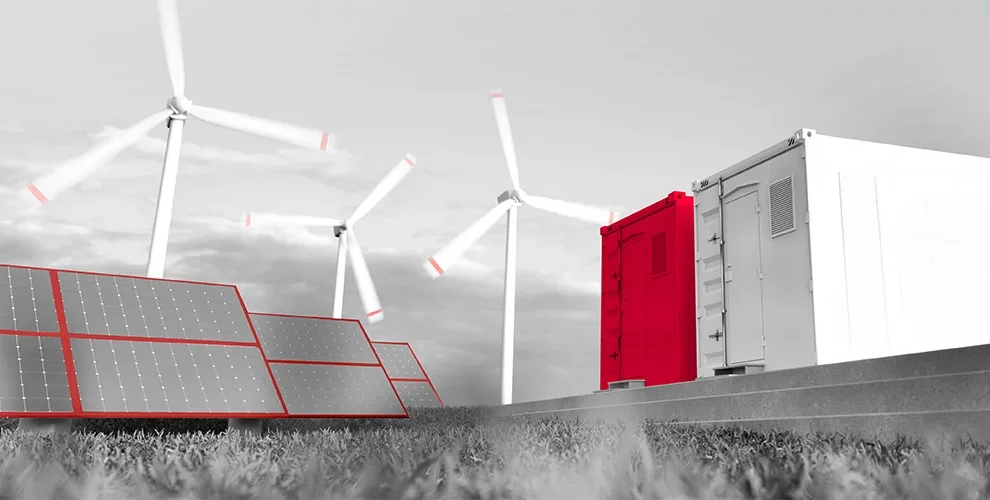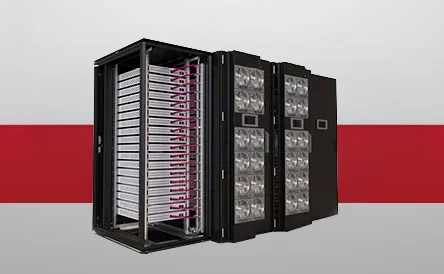Trends in Footprint Reduction for Energy Storage
To build a low carbon future, the world needs to reduce its dependence on fossil fuels and transition to using more renewable energy. Energy storage is a critical technology for this transition. Because renewable sources cannot produce power on demand in the same way that legacy power generation technologies can, energy must be reliably stored to bridge the gap between when it is generated and when people need it. Solar energy presents a particularly clear challenge: solar power is produced during the day when it is sunny out, and people need to use more power in the evening when it is dark out.
Bridging the Gap
Battery energy storage systems (BESSs) help bridge that gap by storing energy in batteries for use at a prescribed rate and time. This decouples time of generation from time of use and allows energy to be delivered when consumers need it. As BESS technology continues to evolve and improve, it can provide improved utilization of renewable resources while improving grid reliability and price stability for consumers.
BESS use extends beyond enabling renewable energy. It is also used in in commercial and industrial applications to enhance reliability of energy availability and reduce costs by using stored power during times when grid power is particularly expensive. Residential homes or small communities can also improve energy independence and environmental sustainability by connecting BESSs to distributed energy resources like rooftop solar.
Increased Adoption, Reduced Footprint
However, to meet the increasing need for energy storage, BESS systems need to get smaller. The International Renewable Energy Agency estimates that 86 percent of the world’s electricity may come from renewables by 2050. This will require a dramatic increase in renewable power generation. This means renewable energy generation needs to become more efficient while taking up less space. Power generation companies need to prioritize using available space to generate renewable electricity. Every square foot spent storing energy instead of generating it presents missed opportunity to deliver power to customers. For this reason, energy storage installations must be made as small as possible while storing as much energy as possible.
Footprint reduction is also important for BESS applications in EV charging stations and commercial and residential building that have limited physical space for energy storage. As EVs become more widely adopted, the EV charging infrastructure buildout has become a major infrastructure initiative. Charging stations need to limit their footprint to meet demand, especially where they are being installed alongside existing gas pumps without increasing real estate footprint. Smaller BESSs help enable this. Similarly, commercial and residential applications may not be able to change the layouts of buildings to accommodate BESSs and therefore need to find ways to fit them into existing architecture.
How to Reduce Energy Storage Footprint
Battery technology is improving, and batteries themselves are getting smaller. However, battery energy storage installations still need the right supporting infrastructure to connect, protect and cool batteries in close proximity to one another. In order to reduce overall the footprint of a battery energy storage installation, it is important to look for efficiencies in how batteries are connected to one another and the system as a whole, as well as to examine the cooling method of the entire system.
Liquid cooling is being deployed in data centers around the world to manage increasing heat density of next-generation AI and ML installations. Liquid cooling is more efficient than air cooling because liquid has a higher heat transfer capacity than air and can get closer to the source of heat. Liquid cooling can be used in energy storage applications to manage the heat loads generated from rising power density. Liquid cooling works in energy storage applications by using a chiller to pump cooled fluid through the system in a closed loop, with precision control adjusting fluid temperature and flow rates to maximize efficiency. By raising the cooling capacity of BESSs with liquid cooling, battery module manufacturers can fit more batteries closer together and increase the power capacity of their installations without increasing footprint.
However, even with batteries appropriately cooled, they need to be connected to one another, and to whatever applications they are powering. Traditional cable solutions, while appropriate in some applications, can be difficult to use when footprint reduction is a primary concern because they often do not have a safe bending radius high enough to accommodate tight turns in small spaces. In these instances, flexible conductors, such as flexible busbars or braids, can offer more design options due to their reduced cross-section and minimal bend radius requirements. These busbars can be prefabricated to save time and labor on job sites
What Next?
As demand for energy storage continues to grow, reducing BESS footprint will be an important process for energy storage manufacturers. Microgrids, EVs and utility-scale renewable energy will all require energy storage solutions that can scale with them to serve power companies, commercial buildings and more. Getting ahead on designs and technology for reducing energy storage footprint will help energy storage companies get out ahead of their competition, and reexamining these systems’ power connections and cooling technologies is a great place to start.
nVent's energy storage solutions simplify design, procurement, manufacturing and site installation while improving total cost of energy. Our solutions improve the total cost of energy and can meet a wide range of applications and environments.
Explore our energy storage solutions: Energy Storage | nVent POWER-UTILITIES


